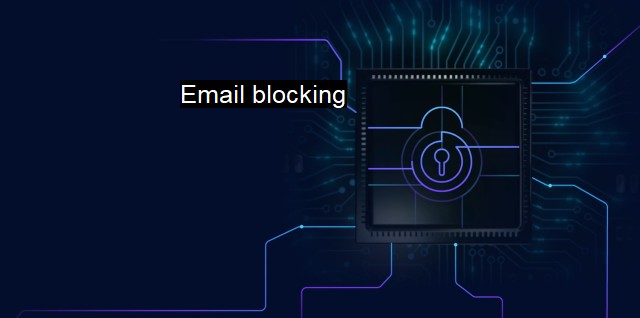What is Email blocking?
Mitigating Email Cybersecurity Risks: Exploring the Uses and Techniques of Email Blocking for Filtering Unwanted and Malicious Content.
Email blocking is a fundamental process used to prevent cyber threats and ensure the safety and integrity of both individual and corporate communication. This practice refers to the defensive maneuver of preventing questionable or harmful emails from reaching a user's inbox. It is a necessary element within a more comprehensive cybersecurity approach, aimed to defend against a wide variety of online threats including phishing attempts, malware, and spam messages.To understand how email blocking works, it is important to note that when an email is sent, it does not go straight from the sender to the recipient but instead passes through several servers. Through these checkpoints, different variables can be evaluated before deciding whether to block or allow an email. The process of email blocking is conducted primarily by internet service providers (ISPs), email bounce back providers, or network administrators using specially designed software or hardware known as firewalls or email security gateways.
Certain criteria and specialized algorithms are used to decide whether an incoming email should be blocked. these protocols may scan the email for suspicious subject lines, specific phrases linked with spam, suspicious senders, or attachments that could potentially contain malware. If any of these characteristics matches with the algorithm's guidelines, the email is blocked automatically. This decision-making process often involves examining the reputation of the sender’s internet protocol (IP) address. If an IP address has previously sent out malicious emails, the likelihood of any email from this address being blocked is quite high.
While security tools for email blocking have proven efficient in preventing many cyber threats, some malicious emails can still slip past filters and land in recipients’ inboxes. well-intentioned emails sometimes get falsely flagged and blocked due to various innocent factors that algorithms interpret as threats. One common cause of false positives is masking, where an email that is structured or coded in a particular way might trigger a false negative. Another reason is that some phishing attacks are not sent from the usual IP addresses known for spam but instead are sent from hacked email accounts, making the strange behaviour less noticeable.
Email blocking remains indispensable in antivirus and cybersecurity measures. It represents a robust first line of defense in an increasingly digitized world where online threats are becoming more complex and if left unchecked, can significantly disrupt business operations or compromise personal information. Protecting against such threats requires an amalgamation of strategies, with email blocking being a critical starting point.
Many contemporary antivirus solutions now incorporate features that involve not just scanning for, isolating and removing detected threats, but also blocking them from even reaching an inbox. This proactive approach stymies online threats in their tracks before they have a chance to compromise the integrity of IT systems or devices.
It is recommended to combine both email blocking solutions with end-user education on how to identify suspicious emails. Through this combination of manual and computer-led defenses, it becomes much harder for cyber threats to breach security measures. email blocking is an integral part of safeguarding cyber environments against an ever-evolving field of online threats.

Email blocking FAQs
What is email blocking?
Email blocking is a security measure that prevents unwanted or suspicious emails from reaching your inbox. It is often used by antivirus and cybersecurity software to protect users from phishing attacks, malware, and other online threats.Why do emails get blocked?
Emails can get blocked for several reasons, including suspected malware or virus attachments, suspicious links, or spam content. Additionally, if the sender's IP address or domain is on a blacklist, their emails may be blocked by email providers.How can I unblock an email that has been blocked?
If an email has been blocked, you can typically find it in your spam or junk folder. You can then mark the email as "not spam" or "not junk" to move it back to your inbox. If the email is not in your spam or junk folder, you may need to contact your email provider to unblock it.Can email blocking prevent all cybersecurity threats?
While email blocking can help prevent many cybersecurity threats, it is not a foolproof solution. Some sophisticated phishing attacks may still make it through email filters, and hackers may find ways to bypass antivirus software. It is important to practice safe browsing habits and use multiple layers of security to protect yourself online.| | A | | | B | | | C | | | D | | | E | | | F | | | G | | | H | | | I | | | J | | | K | | | L | | | M | |
| | N | | | O | | | P | | | Q | | | R | | | S | | | T | | | U | | | V | | | W | | | X | | | Y | | | Z | |
| | 1 | | | 2 | | | 3 | | | 4 | | | 7 | | | 8 | | |||||||